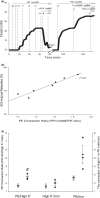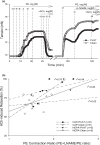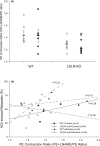A novel evaluation of endothelial dysfunction ex vivo: "Teaching an Old Drug a New Trick"
- PMID: 34755498
- PMCID: PMC8579072
- DOI: 10.14814/phy2.15120
A novel evaluation of endothelial dysfunction ex vivo: "Teaching an Old Drug a New Trick"
Abstract
Cardiovascular disease (CVD) is the leading cause of morbidity and mortality worldwide. Many CVDs begin with endothelium dysfunction (ED), including hypertension, thrombosis, and atherosclerosis. Our assay evaluated ED in isolated murine aorta by quantifying phenylephrine-induced contractions (PE) in the presence of L-NAME, which blocked acetylcholine-induced relaxation (ACh %; >99%). The "L-NAME PE Contraction Ratio" (PECR) was defined as: "PE Tension post-L-NAME" divided by "PE Tension pre-L-NAME." We hypothesized that our novel PE Contraction Ratio would strongly correlate with alterations in endothelium function. Validation 1: PECR and ACh % values of naïve aortas were strongly and positively correlated (PECR vs. ACh %, r2 = 0.91, n = 7). Validation 2: Retrospective analyses of published aortic PECR and ACh % data of female mice exposed to filtered air, propylene glycol:vegetable glycerin (PG:VG), formaldehyde (FA), or acetaldehyde (AA) for 4d showed that the PECR in air-exposed mice (PECR = 1.43 ± 0.05, n = 16) correlated positively with the ACh % (r2 = 0.40) as seen in naïve aortas. Similarly, PECR values were significantly decreased in aortas with ED yet retained positive regression coefficients with ACh % (PG:VG r2 = 0.54; FA r2 = 0.55). Unlike other toxicants, inhaled AA significantly increased both PECR and ACh % values yet diminished their correlation (r2 = 0.09). Validation 3: To assess species-specific dependence, we tested PECR in rat aorta, and found PECR correlated with ACh % relaxation albeit less well in this aged and dyslipidemic model. Because the PECR reflects NOS function directly, it is a robust measure of both ED and vascular dysfunction. Therefore, it is a complementary index of existing tests of ED that also provides insight into mechanisms of vascular toxicity.
Keywords: L-NAME; aldehydes; cardiovascular disease; eNOS; endothelium.
© 2021 The Authors. Physiological Reports published by Wiley Periodicals LLC on behalf of The Physiological Society and the American Physiological Society.
Conflict of interest statement
All authors declare no conflicts of interest in this paper. The content is solely the responsibility of the authors and opinions shared in this publication do not necessarily represent the official views of the National Institutes of Health, the Food and Drug Administration, the U.S. Environmental Protection Agency, or the American Heart Association.
Figures





Similar articles
-
Electronic cigarette solvents, pulmonary irritation, and endothelial dysfunction: role of acetaldehyde and formaldehyde.Am J Physiol Heart Circ Physiol. 2021 Apr 1;320(4):H1510-H1525. doi: 10.1152/ajpheart.00878.2020. Epub 2021 Feb 5. Am J Physiol Heart Circ Physiol. 2021. PMID: 33543686 Free PMC article.
-
L-NAME inhibits Mg(2+)-induced rat aortic relaxation in the absence of endothelium.Br J Pharmacol. 1999 Sep;128(2):493-9. doi: 10.1038/sj.bjp.0702737. Br J Pharmacol. 1999. PMID: 10510463 Free PMC article.
-
Endothelial dysfunction in rat adjuvant-induced arthritis: up-regulation of the vascular arginase pathway.Arthritis Rheum. 2011 Aug;63(8):2309-17. doi: 10.1002/art.30391. Arthritis Rheum. 2011. PMID: 21484767
-
Neuronal nitric oxide synthase-derived hydrogen peroxide is a major endothelium-dependent relaxing factor.Am J Physiol Heart Circ Physiol. 2008 Dec;295(6):H2503-11. doi: 10.1152/ajpheart.00731.2008. Epub 2008 Oct 24. Am J Physiol Heart Circ Physiol. 2008. PMID: 18952716
-
Glutathione (GSH) and the GSH synthesis gene Gclm modulate vascular reactivity in mice.Free Radic Biol Med. 2012 Sep 15;53(6):1264-78. doi: 10.1016/j.freeradbiomed.2012.07.006. Epub 2012 Jul 21. Free Radic Biol Med. 2012. PMID: 22824862 Free PMC article.
Cited by
-
Role of the Transient Receptor Potential Ankyrin-1 in the Pulmonary, Vascular, and Systemic Effects of Short-Term Acrolein Inhalation in Mice: Implications for the Toxicity of Electronic Nicotine Delivery Systems.Cardiovasc Toxicol. 2025 Apr;25(4):523-540. doi: 10.1007/s12012-025-09978-2. Epub 2025 Feb 25. Cardiovasc Toxicol. 2025. PMID: 40000582
-
Formaldehyde and the transient receptor potential ankyrin-1 contribute to electronic cigarette aerosol-induced endothelial dysfunction in mice.Toxicol Sci. 2024 Oct 1;201(2):331-347. doi: 10.1093/toxsci/kfae096. Toxicol Sci. 2024. PMID: 39067042 Free PMC article.
References
-
- Benjamin, E. J. , Muntner, P. , Alonso, A. , Bittencourt, M. S. , Callaway, C. W. , Carson, A. P. , Chamberlain, A. M. , Chang, A. R. , Cheng, S. , Das, S. R. , Delling, F. N. , Djousse, L. , Elkind, M. S. V. , Ferguson, J. F. , Fornage, M. , Jordan, L. C. , Khan, S. S. , Kissela, B. M. , Knutson, K. L. , … Virani, S. S. (2019). Heart disease and stroke statistics‐2019 update: A report from the American Heart Association. Circulation, 139, e56–e528. 10.1161/CIR.0000000000000659 - DOI - PubMed
Publication types
MeSH terms
Substances
Grants and funding
LinkOut - more resources
Full Text Sources

